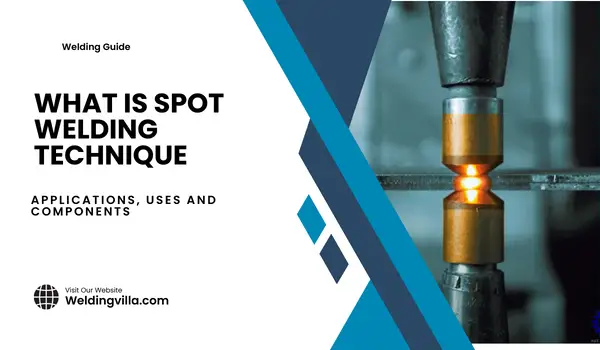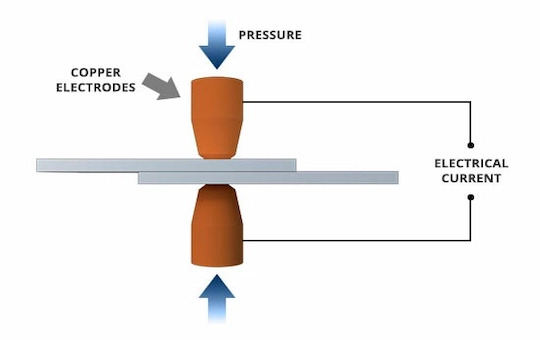What is Spot Welding & How Does it Work? Components and Applications
Updated: 1 Mar 2024
60
We have heard of various kinds of welding, but one technique, spot welding, is used in multiple industrial projects. The spot welding technique (resistance welding process)is a liquid-stage welding process where heat and pressure with current are provided to the metal pieces to create a strong weld through copper-shaped electrodes.
This technique plays a vital role in welding areas such as construction sites and industrial zones, making the work more reliable, convenient, and less time-consuming, with minimum budget requirements. Below, we will explain briefly what spot welding is, how it works, and the different components used in this welding process.
What is Spot Welding? Let’s Dig Inside:

Spot welding is one of the processes of welding where a current is provided with heat and pressure to weld two pieces of metal together. This type of welding is also called the resistance welding process because the resistance of the workpiece and electrodes combine two metals or sheets by generating heat through an electric current applied to the interface of the two metals.
How Does Spot Welding Work?

Source: https://www.twi-global.com/technical-knowledge/faqs/what-is-spot-welding
Spot welding works in three main stages.
In the first stage, the electrode is brought toward the metal surface of the metals and applies a small amount of pressure.
The current will be applied through the electrode on the metals; in the next step, the current will be removed, and the electrode will remain on the metals. It will be removed when the metals cool.
The last and most crucial stage of spot welding is that the current range is applied to the electrodes for short intervals, about 0.01 sec to 0.63 sec, depending on the metals’ thickness and the electrode’s diameter during welding.
The amount of heat depends on the metal’s thermal conductivity, electrical resistance, and the time the current is applied.
So, the above process of spot welding works under the equation below, which can describe the whole process.
Equation ==> Q = I2Rt
The below equation shows that “Q” is heat energy, “I” is current, “R” is electrical resistance, and “T” is the time for which current is applied to the welding materials.
5. Applications of Spot Welding:
Spot welding is an essential technique used in various industries and manufacturing zones with the following applications.
The Aerospace Industry.
The Spot welding technique is used in the Aerospace industry to ensure the lightweight and rapid assembly of various panels, components, and aircraft structures in manufacturing. Thanks to its high strength ability, this process can provide more power to the parts of the aircraft, including worksheets, different components, and metal parts, without adding excessive weight.
Automotive Industries:

In automobile industries, spot welding is vital in joining different parts quickly and without wasting time during manufacturing.
The excellent part of spot welding is covering the project on time. That is the reason the automotive industry manufacturers and contractors chose the spot welding process to quickly assemble the parts of the Vehicles and cover the welding process on time.
Electronic Manufacturing:
In electronic industries, spot welding is used in various electronic appliances such as refrigerators and multiple types of machinery, for example, washing machines where the metal plates are welded through spot welding.
In addition, in battery-making industries (lithium-ion), expert welders want to choose a spot welding technique to weld battery plates to avoid excessive materials or fillers that make it difficult to carry from one place to another.
Construction and Metal Fabrication:

In different construction projects, spot welding welds steel beams and frame components in heavy construction projects. Solid and permanent connections are provided in metal fabrications, which make the structure integrity of materials and framework in any project.
For example, the ventilation duct is the best example of spot welding because they are built very light to provide better ventilation in the building area; that is why the welders use the Spot welding process to weld the ventilation duct without putting a heavy load on it. It may cause cracks, fall-down risk, and holes in the ventilation part during building construction.
Also, check the complete video about the spot welding basics.
Components of Spot Welding:
Spot welding has multiple components which are used in the process.
Welding Electrodes:
The electrodes are mainly made of copper or copper alloy for high conductivity and heat resistance, which is used in spot welding. The electrodes conduct the electric current, which is transferred toward the metal piece to weld it.
Welding Power Source:
In the spot technique, the power source is utilized DC (Direct Current), due to which direct current is reliable in low voltage to metals. They provide electric current constantly in one direction. However, some manufacturing industries use AC (Alternative current) depending on the materials used for the welding process.
Used for Multiple Workpieces:
Multiple workpieces are needed to weld in different industrial zones, requiring various materials. The spot welding process fills the space in that confusing state. So there, a welder uses different materials like aluminum, copper, or their alloys to weld various metal sheets.
For example, welders mostly used copper, aluminum, and silver to weld different electric parts.
Advantages of Spot Welding:
There are several benefits, some of which are given below;
Efficiency:
Spot welding is efficient in welding large weld pieces in short intervals. It is mainly used in different industries to get more production in short intervals of time.
Cost-Effectiveness:
The significance of spot welding is low cost, few materials used, and energy consumption. It is used due to the low budget required, and no extra materials are used during welding.
Strength:
Like maximum efficiency, the spot welding technique is also famous for its high strength, which produces solid and reliable welds in various welding projects. It is permanent welding of high strength compared to others, depending on the materials and manufacturing zones.
Versatility:
Versatility is essential in welding because it has a wide range of materials and thicknesses. Spot welding is also versatile on metal alloys, for example, aluminum, copper alloy, and vice versa. The process works smoothly and can be applied to any material easily.
Ideal for Lightweight Materials:
Spot welding is a good idea for lightweight materials. Welding the two metals brought together for welding is quite tricky in spot welding, so it is the best idea for lightweight aluminum in the welding process.
Challenges and Limitations of Spot Welding:
Below, we have compiled a list of some hurdles and limitations that the welders face in the Spot welding process.
Thermal Distortion:
Spot welding also faces challenges and limitations, such as thermal distortion, which may be distorted during welding. Some materials are caused by wrapping due to excessive heat, which deforms or is unshaped.
Material Compatibility:
Some of the materials used in spot welding are limited due to the lower electrical conductivity of certain materials. For example, aluminum alloy, which works with any materials used, is complex to join because of materials limitations and is used due to the welding process.
Joint Accessibility:
Difficulty in reaching certain areas for welding some limitation
Spot welding is used in some industries, but therefore, some industries avoid the reason that the weld is difficult to reach specific areas of joints.
Equipment cost:
The initial investment required for spot welding machines is very high, so the construction project and metals fabrication avoid them and complete the project. It may cause a burden on any industries in the industrial projects due to cost-effectiveness.
FAQs:
What is meant by spot welding?
Spot welding joins two welding metal sheets by applying pressure and heat from the electric current to the weld area. This welding is also called resistance spot welding.
Do spot welders use AC or DC?
Yes, both of them are used in spot welding by welders. It depends on the welding materials and which type of workpieces you weld. Some materials require direct current(DC), and others require alternative current(AC).
Who uses spot welders?
Mainly, the automotive industries use spot welding. The reason is that different parts and sheet metals are assembled quickly in the industries, requiring sound efficiency output in short intervals.
Ending Points:
Spot welding uses pressure and electric current in industrial projects for efficiency. It involves electrodes and applying current for a short interval based on metal thickness. Components include copper electrodes and various workpieces like aluminum.
Most welding experts are recommended in various industries. Still, others are avoided due to some of the limitations, such as material thickness and hurdles to reaching certain areas of metal sheets. At the same time, spot welding is more convenient and time-saving in welding projects.
If you want more knowledge about welding-related resources, you can visit our website for more details on welding-related topics, which will be helpful for you.
Please Write Your Comments